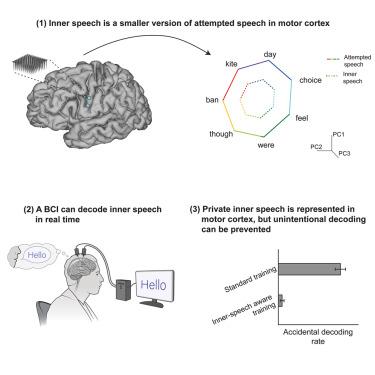Inner speech in motor cortex and implications for speech neuroprostheses
IF 42.5
1区 生物学
Q1 BIOCHEMISTRY & MOLECULAR BIOLOGY
引用次数: 0
Abstract
Speech brain-computer interfaces (BCIs) show promise in restoring communication to people with paralysis but have also prompted discussions regarding their potential to decode private inner speech. Separately, inner speech may be a way to bypass the current approach of requiring speech BCI users to physically attempt speech, which is fatiguing and can slow communication. Using multi-unit recordings from four participants, we found that inner speech is robustly represented in the motor cortex and that imagined sentences can be decoded in real time. The representation of inner speech was highly correlated with attempted speech, though we also identified a neural “motor-intent” dimension that differentiates the two. We investigated the possibility of decoding private inner speech and found that some aspects of free-form inner speech could be decoded during sequence recall and counting tasks. Finally, we demonstrate high-fidelity strategies that prevent speech BCIs from unintentionally decoding private inner speech.

运动皮质内言语及其对言语神经假体的影响
语言脑机接口(bci)有望恢复瘫痪患者的沟通,但也引发了关于其解码私人内心语言的潜力的讨论。另外,内部语音可能是一种绕过当前要求语音BCI用户进行物理尝试的方法的方法,这种方法既疲劳又会减慢通信速度。通过对四名参与者的多单元录音,我们发现内在言语在运动皮层中得到了强有力的表征,并且想象的句子可以实时解码。内部言语的表现与言语尝试高度相关,尽管我们也发现了一个神经“运动-意图”维度来区分这两者。我们研究了私人内部语音解码的可能性,发现在序列回忆和计数任务中,自由形式的内部语音的某些方面可以被解码。最后,我们展示了高保真策略,防止语音脑机接口无意中解码私人内部语音。
本文章由计算机程序翻译,如有差异,请以英文原文为准。
求助全文
约1分钟内获得全文
求助全文
来源期刊

Cell
生物-生化与分子生物学
CiteScore
110.00
自引率
0.80%
发文量
396
审稿时长
2 months
期刊介绍:
Cells is an international, peer-reviewed, open access journal that focuses on cell biology, molecular biology, and biophysics. It is affiliated with several societies, including the Spanish Society for Biochemistry and Molecular Biology (SEBBM), Nordic Autophagy Society (NAS), Spanish Society of Hematology and Hemotherapy (SEHH), and Society for Regenerative Medicine (Russian Federation) (RPO).
The journal publishes research findings of significant importance in various areas of experimental biology, such as cell biology, molecular biology, neuroscience, immunology, virology, microbiology, cancer, human genetics, systems biology, signaling, and disease mechanisms and therapeutics. The primary criterion for considering papers is whether the results contribute to significant conceptual advances or raise thought-provoking questions and hypotheses related to interesting and important biological inquiries.
In addition to primary research articles presented in four formats, Cells also features review and opinion articles in its "leading edge" section, discussing recent research advancements and topics of interest to its wide readership.
 求助内容:
求助内容: 应助结果提醒方式:
应助结果提醒方式:


